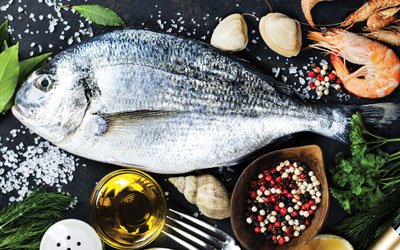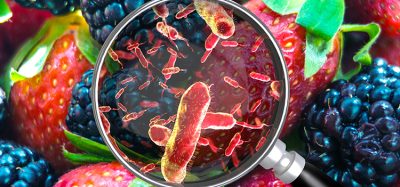Contaminants & Drug Residues: Safe seafood consumption for pregnant women and young children
- Like
- Digg
- Del
- Tumblr
- VKontakte
- Buffer
- Love This
- Odnoklassniki
- Meneame
- Blogger
- Amazon
- Yahoo Mail
- Gmail
- AOL
- Newsvine
- HackerNews
- Evernote
- MySpace
- Mail.ru
- Viadeo
- Line
- Comments
- Yummly
- SMS
- Viber
- Telegram
- Subscribe
- Skype
- Facebook Messenger
- Kakao
- LiveJournal
- Yammer
- Edgar
- Fintel
- Mix
- Instapaper
- Copy Link
Posted: 1 September 2015 | Edward Groth III, Groth Consulting Services | 2 comments
Providing fish consumption advice for pregnant women and young children requires weighing risk-benefit trade-offs. Seafood (I will use the words ‘fish’ and ’seafood’ interchangeably here to include both finfish and shellfish) provides important nutrients, such as the omega-3 polyunsaturated fatty acids (n-3s) docosahexaenoic acid (DHA) and eicosapentaenoic acid (EPA), which are essential for prenatal nervous system development. However, fish consumption is also the primary route of exposure to methylmercury, which is neurotoxic.


Even mildly elevated exposure to methylmercury before and after birth can damage the developing brain. Currently, many pregnant women do not eat enough fish to supply the n-3s their babies need, so public health can be improved substantially by persuading women to eat more fish. Women also need guidance to choose low mercury seafood varieties in order to minimise the risk of possible adverse effects. Clear advice on smart seafood choices can increase women’s confidence that their fish consumption will be beneficial, not harmful to their baby, so providing better advice may be a key strategy for getting pregnant women to eat more fish.
Pregnant women and parents of young children are the primary targets for fish consumption advice because the developing brain is especially sensitive to methylmercury toxicity. Other risk factors include eating more fish than average, ethnic diets with high fish content, and preferring to eat larger, predatory species like swordfish and tuna, which have higher mercury levels. Sound advice on seafood choices can help the many different population groups who need to manage their methylmercury exposure do so, while continuing to enjoy fish.
To be effective, fish consumption advice needs to be soundly based on current scientific knowledge of the benefits and the risks associated with different seafood choices, and also must be helpful and easy for consumers to understand and follow. Research on the benefit/risk questions and analytical methods for weighing risks and benefits have expanded rapidly in recent years. There is no consensus on the best approach yet, and opinions as to what is ‘good advice’ differ. I will offer here my own approach to seafood choice advice and describe the evidence that supports it.
Epidemiological evidence for beneficial effects
My grandmother used to say: “Fish is brain food.” She was right, but strong evidence to support that conclusion has emerged only in the past decade or so. The Avon Longitudinal Study of Parents and Children (ALSPAC), a large prospective cohort study in the United Kingdom, examined environmental, dietary and family factors that can affect prenatal and postnatal development. They assessed children’s cognitive development at ages from six months to eight years, finding improved verbal development in children whose mothers ate fish one to three times a week during pregnancy, compared with children whose mothers ate no fish3, and associating decreased risk of a lower verbal IQ score with increased maternal fish consumption.
An analysis of data from the Danish National Birth Cohort, a study of 25,445 mother/child pairs, found that children of mothers with higher fish intake during pregnancy were more likely to score higher for various developmental milestones, such as speaking or drawing4. Several smaller studies that looked mostly for adverse effects of prenatal methylmercury exposure have associated beneficial effects with maternal fish consumption. Several clinical trials in which women were given n-3 supplements during pregnancy or while breastfeeding have also found benefits for babies’ developing brains5.
The number of studies on this topic is relatively small, and more data are always desirable, but it seems clear that fish consumption during pregnancy improves cognitive development in many ways. Some studies (not all) suggest that two to three fish meals (about 8-12oz) per week provide optimal benefits. Since many women of childbearing age in western countries eat less fish than that, emphasis on increasing fish consumption during pregnancy is well justified.
Epidemiological evidence for adverse effects
Severe neurotoxic effects of methylmercury from eating fish were first observed in industrial pollution incidents in Minamata and Niigata, Japan, in the 1950s and 60s. Studies of victims of those tragic events also documented the heightened vulnerability of the developing nervous system to methylmercury toxicity.
Research in the 1980s and 90s explored whether methylmercury exposure from ordinary seafood consumption (i.e. without localised pollution) in populations with high fish diets had similar but milder adverse health effects. Studies in New Zealand and in the Faroe Islands found deficits in cognitive development in children with elevated prenatal methylmercury exposure (such as Grandjean et al. (1997)6). A similar study in the Seychelles at first failed to link adverse effects with methylmercury exposure7. In trying to understand why their results differed, the Faroes and Seychelles researchers discovered that beneficial effects of fish nutrients had partially or fully obscured the adverse effects of methylmercury, and vice-versa, in both studies8,9.
Since 2005 or so, research has examined the possibility that methylmercury exposure even at doses associated with typical, ordinary amounts of fish consumption may have subtle adverse effects on developing cognitive functions. Several studies have been well designed to account for the mutual confounding between mercury exposure and beneficial nutrients in fish, and thus have measured both beneficial and adverse effects fairly precisely.
More than 20 epidemiological studies of methylmercury effects on the developing nervous system have been published in the past decade, and the vast majority have observed adverse effects. Studies come from 10 different countries, have examined children aged from three days to 11 years, and have measured dozens of different cognitive endpoints, ranging from early language and memory functions to attention deficit hyperactivity disorder. This research is too complex to describe in detail here, but readers who want more information and references to the individual studies can see my recent review10.
Putting methylmercury exposure in context
Overall, recent epidemiological studies show two things. First, beneficial and adverse effects are both associated with fish consumption during pregnancy, and in many cases, the harmful effects are as large as or larger than the beneficial ones. Depending on the cognitive functions measured, methylmercury effects have ranged from deficits of a few percent to more than 25% on the performance indices examined. Second, the doses of methylmercury linked with adverse effects in recent studies are about an order of magnitude lower than those considered harmful even a few years ago and well within the range of typical exposures from everyday fish consumption for women in many countries. Daily mercury doses of 6µg or more (or weekly doses of around 42µg or more) have now been associated with adverse effects in more than a dozen recent studies. While there are many differences among studies, the cohorts examined were often small, and more research is clearly needed, these conclusions seem inescapable.
To put the dose in perspective, a 6oz serving of canned albacore tuna contains about 60µg of mercury, so a woman who ate that fish once a week would consume about 1.5x the minimal dose now associated with adverse effects. In comparison, 6oz of swordfish contains about 170µg of mercury, while 6oz of salmon contains only about 3µg. Epidemiological evidence thus underscores the urgency of advising pregnant women to choose fish like salmon, and to avoid those like tuna or swordfish that are much higher in mercury.
Data assembled by the US Food and Drug Administration show that individual fish and shellfish items vary by more than 150-fold in mercury content and by about 70-fold in n-3 content; the n-3/Hg ratios of 47 varieties in FDA’s database vary by 1,360-fold. That is, the risk/benefit profiles of different seafood varieties vary enormously. Since popular fish species cannot be banned from the market, and pollution controls (while essential) cannot significantly reduce mercury levels in the oceans for a long time, guiding pregnant women to choose wisely among popular seafood varieties must be the primary strategy for improving health outcomes, for individuals and for society as a whole.
Risk-benefit models
Several research teams have developed computer models to compare the benefits and risks of different seafood types and support fish consumption advice. The models use survey data on fish consumption, data on the mercury and n-3 content of different fish species, dose-response data for beneficial and adverse effects from the literature, and various other assumptions and data to generate estimates of the net effects on cognitive development of eating different fish and shellfish during pregnancy. Results of one such model, developed in the EU, are shown in Figure 111.
Risk-benefit models are potentially very useful tools for ranking seafood choices and advising consumers, but this science is still quite young, and different models have produced wildly different results. For instance, while the model shown in Figure 1 shows that many fish with higher mercury levels would have large net adverse effects if consumed during pregnancy, a model developed by an expert group assembled by the FAO/WHO reached the opposite conclusion, that the benefits of eating any amount of any fish during pregnancy will always exceed the risks12.
Differences in model results reflect the different and often arbitrary assumptions and data choices made by different modellers. As one early modeller famously quipped: “All models are wrong; some models are also useful.”13 In fact, the FAO/WHO model predicts a net IQ gain for a child whose mother ate 700g of swordfish, containing 1,050µg of mercury every week while pregnant. That dose is 25x higher than doses repeatedly associated with adverse effects in recent epidemiological studies, and is also 25x higher than the US Reference (maximum acceptable) Dose. Given other evidence, FAO/WHO’s model is clearly very seriously ‘wrong’, but the conclusion that ‘the benefits always outweigh the risks’ has been widely, and usually uncritically, quoted.
If tempered with awareness of epidemiological evidence, benefit-risk models can indeed be useful tools for generating seafood choice advice. I started with a model developed by the US FDA14, made some adjustments to reflect the best recent dose-response data, and generated a chart (Figure 2) sorting seafood into five categories, based on recommended frequency of consumption by pregnant women10. The seafood items shown in the chart are from the FDA database and represent the US market. Similar seafood choice charts could be developed for other countries.
I believe this chart is an effective, science-based and consumer-friendly communication tool. By showing myriad choices with favourable benefit-risk ratios that women can eat often (i.e. the left-hand columns) and also identifying items with less favorable ratios to eat less often or not at all (the right columns), the chart guides women (and anyone else who needs such advice) to smart seafood choices. Results of sounder seafood choices should include increased fish consumption and improved individual and public health outcomes.
References
- Hibbeln, JR et al. Maternal seafood consumption in pregnancy and neurodevelopmental outcomes in childhood (ALSPAC study): an observational cohort study. Lancet 369, 578–585 (2007).
- Karagas, MR et al. Evidence on the human health effects of low-level methylmercury exposure. Environmental Health Perspectives 120, 799-806 (2012).
- Daniels, JL, Longnecker, MP, Rowland, AS & Golding, J. Fish intake during pregnancy and early cognitive development of offspring. Epidemiology 15, 394–402 (2004).
- Oken, E et al. Associations of maternal fish intake during pregnancy and breastfeeding duration with attainment of developmental milestones in early childhood: a study from the Danish National Birth Cohort. American Journal of Clinical Nutrition 288, 789–796 (2008).
- Smithers, LG, Gibson, RA & Makrides, M. Maternal supplementation with docosahexaenoic acid during pregnancy does not affect early visual development of the infant: a randomized controlled trial. American Journal of Clinical Nutrition 93, 1,293-1,299 (2011).
- Grandjean, P et al. Cognitive deficit in 7-year-old children with prenatal exposure to methylmercury. Neurotoxicology and Teratology 19, 417–428 (1997).
- Myers, GJ et al. Prenatal methylmercury exposure from ocean fish consumption in the Seychelles Child Development Study. Lancet 361, 1,686–1,692 (2003).
- Budtz-Jørgensen, EP, Grandjean, P & Weihe, P. Separation of risks and benefits of seafood intake. Environmental Health Perspectives 115, 323–327 (2007).
- Davidson, PW et al. Neurodevelopmental effects of maternal nutritional status and exposure to methylmercury from eating fish during pregnancy. Neurotoxicology 29, 767-775 (2008).
- Groth, E. Scientific foundations of fish-consumption advice for pregnant women: epidemiological evidence, risk-benefit modeling, and an integrated approach. Submitted for publication.
- Zeilmaker, MJ et al. Fish consumption during child bearing age: A quantitative risk-benefit analysis on neurodevelopment. Food and Chemical Toxicology 54, 30-34 (2013).
- Food and Agriculture Organization/World Health Organization (FAO/WHO). Report of the Joint FAO/WHO Expert Consultation on the Risks and benefits of Fish Consumption, Rome, 25-29 January 2010. FAO Fisheries and Aquaculture Report No. 978. Rome, FAO (2011).
- Box, GEP, and Draper, NR. Empirical Model Building and Response Surfaces. New York: John Wiley & Sons, 424 (1987).
- US Food and Drug Administration (US FDA). A quantitative assessment of the net effects on fetal neurodevelopment from eating commercial fish (as measured by IQ and also by early age verbal development in children). Published online by the US FDA in June, 2014. Available at: http://www.fda.gov/Food/FoodborneIllnessContaminants/Metals/ucm393211.htm.
About the author
Edward (Ned) Groth III has a PhD in Biology and Public Policy and has worked on environmental health and food safety issues since the 1960s. For many years he was a senior scientist with the Consumers Union of the US, where he carried out risk assessments and risk communication on food safety issues and toxic substances in consumer products, retiring in 2004. He has advised US government agencies, the World Health Organization and the Food and Agriculture Organization on many topics, including food safety risk analysis, risk communication, and managing the risks from methylmercury in fish.








I had to give up sashimi when I was pregnant as my doctor said it’s not safe. Oh, well, small sacrifices you make for the baby, especially as getting pregnant was hard for me. Hormone tests, OPKs (got them for free at ttckit.com), watching my diet and my weight and giving up sushis and sashimis, horrible morning sickness, no sacrifice is too much!
I disliked the smell of any seafood when I was pregnant, before I even knew I was pregnant. We’ve been TTC for years, was taking conceiveeasy without knowing I was already pregnant, wasn’t really expecting but I just couldn’t stand any seafood smell. But it is good to know, what to avoid…